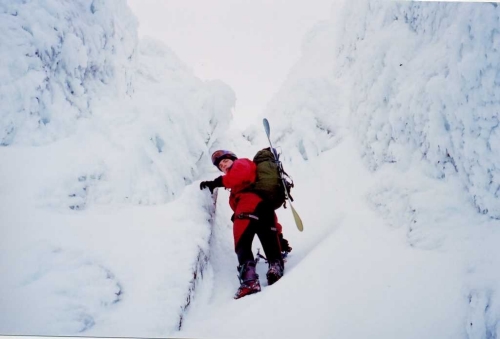Mark Raistrick

M.Sc. Thesis
Depleted Mantle Derived Magmas and Laurentian Detritus in the Supracrustal Lighthouse Gneiss Association, Grenville Province, Ontario
(PDF - 9 Mb)
The juvenile supracrustal rocks of the Lighthouse gneiss association are part of the Shawanaga domain of the Central Gneiss Belt, southwestern Grenville Province, Ontario. The Shawanaga domain is overlain by the lithologically distinctive, thrust emplaced Parry Sound domain to the southeast, and underlain by the Britt domain of the Laurentian continental margin to the northwest. The Britt domain has experienced both Grenvillian (ca. 1120 980 Ma), and older (ca. 1450 Ma) metamorphism, whereas the Parry Sound and Shawanaga domains only record Grenvillian events.
The upper and lower units of the Lighthouse gneiss association, separated by a narrow anorthosite body, consist of interlayered feldspathic metasediments and tholeiitic amphibolite. The Lighthouse gneiss association was highly deformed and metamorphosed to upper amphibolite facies during the Grenville orogenic cycle (ca. 1050 Ma). The protoliths of the Lighthouse gneiss association were likely to have been supercrustal rocks formed in a marginal volcanic basin(s).
U Pb geochronology of detrital zircons from a lower unit metasediment revealed only single age 1380 Ma zircons, similar ages to the subjacent Sand Bay gneiss association. Amphibolites accompanying the lower unit metasediments have eNd values (mean: +5.4 at 1370 Ma) similar to the DM (depleted mantle) at their time of formation, suggesting little or no ontamination by older felsic crustal material. Trace element data suggests subduction modification of the DM source. The volcanic and sedimentary protoliths of the lower unit appear to have been formed soon after 1380 Ma, adjacent to the Laurentian Sand Bay gneiss association, and the contemporaneous southern mid continent granite rhyolite province, on juvenile Laurentian continental crust. The lower unit may represent the later stages of rifting of a continental back arc basin, with the Sand Bay bimodal metavolcanics and siliciclastic metasediments as earlier products of the same process.
The upper unit amphibolites, like the lower unit, have eNd values within error of the DM at 1320 Ma, (mean: +5.7) suggesting that magmas did not interact in any significant way with older crustal rocks. Upper unit amphibolite trace element distribution suggests a MORB-like DM source. Metasediment detrital zircon age ranges from the upper unit vary from 1880 1330 Ma, and resemble ages found both on the Laurentian margin and in allochthonous rocks probably formed on the most distal parts of the Laurentian margin, in particular the Parry Sound domain and parts of the Frontenac Adirondack Belt. It is probable that the upper unit formed in a more distal, outboard setting with respect to the lower unit and Sand Bay gneiss association, and while the basin in which the upper unit was deposited continued to receive continental detritus, magmas were not appreciably contaminated by older material, or altered by subduction zone processes.
This study supports models that treat the Mesoproterozoic history of the southwestern Laurentian margin as a series of oceanward younging juvenile continental arcs.
Combined U Pb detrital geochronological and Nd isotope petrogenetic studies, along with lithological, field, geochemical and correlative data allow identification of environments of origin, where individual interpretations of the U Pb and Nd isotopic systems can be ambiguous.
Keywords:
Pages: 151
Supervisor: Nicholas Culshaw



